Appeal to City Council on Building Multi Family, Can We Take Back Our Appeal and Get Your Money Back
Glossary of Zoning Terms
This glossary provides brief explanations of planning and zoning terminology, including terms highlighted in the Zoning Handbook. Words and phrases followed by an asterisk (*) in the Glossary are legally defined terms in the Zoning Resolution of the Urban center of New York, and can be constitute primarily in Department 12-10 of the Resolution for the complete legal definitions.
- Accessory Apply*
- An accessory use is a apply that is incidental to and customarily establish in connectedness with the principal utilise. An accessory use must be conducted on the same zoning lot as the principal use to which information technology is related, unless the district regulations allow another location for the accessory use. (Off-site accessory parking facilities, for example, are permitted in certain zoning districts.)
- Air Rights (see Development Rights)
- Arts Bonus (meet Incentive Zoning)
- As-of-right Evolution
- An every bit-of-right evolution complies with all applicable zoning regulations and does not crave any discretionary activeness by the Urban center Planning Commission or Board of Standards and Appeals. Most developments and enlargements in the city are as-of-correct.
- Attached Building* (see Building)
- Cranium Allowance
-
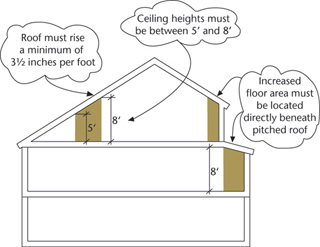
Cranium Allowance
An attic allowance is an increase of up to 20 pct in the maximum flooring surface area ratio (FAR) for the provision of a pitched roof. The allowance is available in R2X districts and all R3 and R4 (except R4B) districts.
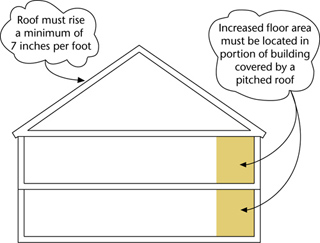
Cranium Allowance in Lower Density Growth Management Areas
Outside of Lower Density Growth Management Areas (LDGMA), the increased floor area must exist directly beneath the pitched roof and have a ceiling height between five and eight feet.
- Authorization
- An authorization is a discretionary action taken past the Metropolis Planning Committee, often after an informal referral to the affected community board(s), which modifies specified zoning requirements if certain findings have been met.
- Base Tiptop
- The base acme of a building is the maximum permitted height of the front end wall of a building before any required setback. A building is required to meet a minimum base of operations tiptop only when the peak of the building will exceed the maximum base height.
- Base Plane*
- The base aeroplane is a horizontal plane from which the height of a building is measured. It is utilized in almost lower-density and contextual districts, and for property subject to waterfront zoning. Often, the base plane is at curb level; on sites that slope upwards or downwardly from a street, or on large lots where buildings are far from a street, the base airplane is adjusted to more accurately reflect the level at which the building meets the ground.
- Basement*
- A basement is a building story that has at to the lowest degree i-half of its floor-to-ceiling meridian above curb level or the base of operations airplane. By contrast, a cellar has at least one-half of its floor-to-ceiling top below curb level or the base of operations aeroplane. A basement is included in floor area calculations.
- Bioswale
- A bioswale is a mural element designed to capture storm water run-off from adjacent surface areas. It has inverted sloped sides that allow rainwater to bleed into it and contains vegetation and mulch designed to remove pollutants before the water infiltrates into the soil. They are required in certain parking lots accessory to commercial and community facility uses.
- Cake*
- A block is a tract of country divisional on all sides by streets or by a combination of streets, public parks, railroad rights-of-style, pierhead lines or airport boundaries.
- Blockfront
- A blockfront is that portion of a block consisting of all of the zoning lots fronting on a single street.
- Lath of Standards and Appeals (BSA)
- The BSA, composed of five commissioners appointed by the Mayor, reviews and grants applications for special permits, as prescribed in the Zoning Resolution, for sure proposed developments and uses. The BSA also grants variances for zoning lots with irregular physical atmospheric condition where construction might non otherwise exist possible. In addition, the Lath hears and decides appeals to determinations by the Section of Buildings.
- Bonus (see Incentive Zoning)
- Building*
-
A edifice is a structure that has one or more floors and a roof, is permanently affixed to the country and is divisional by open up areas or the lot lines of a zoning lot.
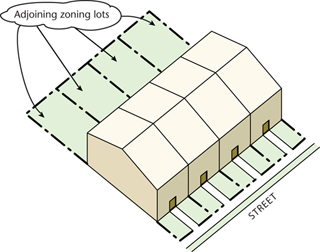
An attached edifice* abuts two side lot lines or is one of a row of abutting buildings.
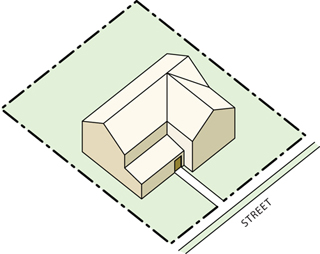
A detached building * is a freestanding edifice that does not abut any other building and where all sides of the edifice are surrounded by yards or open up areas within the zoning lot.
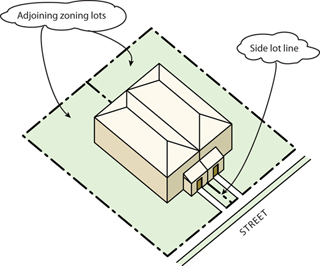
A semi-detached building * is a edifice that abuts or shares a wall, on a side lot line, with some other building on an adjoining zoning lot and where the remaining sides of the building are surrounded by open up areas or street lines.
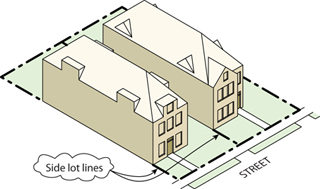
A nix lot line building * is a freestanding building that abuts 1 side lot line of a zoning lot and does not adjoin whatever other building on an adjoining zoning lot.
- Edifice Envelope
-
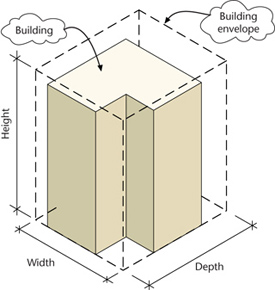
A building envelope is the maximum iii-dimensional space on a zoning lot within which a structure can be built, every bit permitted past applicable summit, setback and g controls.
- Building Height
- Building superlative refers to a building'southward superlative equally measured from the curb level or base airplane to the roof of the building (except for permitted obstructions, such equally elevator bulkheads).
- Building Segment*
- A building segment is a portion of a building where each portion has one or more home units served by a sepacharge per unit entrance. For case, a row of attached townhouses is comprised of edifice segments.
- Bulk
- Bulk regulations are the combination of controls (lot size, floor expanse ratio, lot coverage, open space, yards, height and setback) that determine the maximum size and placement of a edifice on a zoning lot.
- Bulkhead
- A bulkhead is an enclosed construction on the roof of a building that may include mechanical equipment, water tanks and roof access from interior stairwells. It is not counted as floor surface area and is permitted to exceed zoning height and setback requirements, within limits specified in the Zoning Resolution.
- Bulkhead Line (meet Waterfront Area)
- Cellar
- A cellar is a level of a edifice that has at least one-half of its flooring-to-ceiling height below adjourn level or the base of operations plane. By contrast, a basement has at least one-half of its flooring-to-ceiling height in a higher place adjourn level or the base plane. A cellar is not included in flooring area calculations.
- Certification
- A certification is a non-discretionary action taken by the City Planning Commission, or its Chairperson, informing the Section of Buildings that an as-of-right development has complied with specific conditions set forth in accordance with provisions of the Zoning Resolution. Certification is likewise the beginning of the ULURP procedure indicating that the Department of City Planning has determined that an awarding is complete and prepare for formal public review.
- Metropolis Environmental Quality Review (CEQR)
-
Pursuant to state law, the City Environmental Quality Review (CEQR) process identifies and assesses the potential environmental impacts of discretionary actions that are proposed by public or private applicants. A discretionary action, such as a zoning map amendment, cannot brainstorm public review until a "provisional negative declaration" or "negative annunciation" has been issued, stating that no significant environmental impacts take been identified or, if whatsoever potential impacts have been identified, a draft ecology affect statement has been completed, evaluating the significance of identified impacts and proposing appropriate mitigation.
A letter "E" designation assigned to a zoning lot indicates a site where environmental requirements must be satisfied before a building permit may exist issued for whatsoever development, enlargement or alter of employ.
- City Map
- The City Map is a collection of maps that show legal streets, grades, parks, pierhead and bulkhead lines, public places and other legally established map elements. It is the official map of New York City and is the base for the zoning maps in the Zoning Resolution. The office of each borough president contains the city maps for that borough.
- City Planning Commission (CPC)
- The Metropolis Planning Commission, established in 1936, is a 13-fellow member panel responsible for the conduct of planning relating to the orderly growth and evolution of the metropolis. The Commission meets regularly to hold public hearings and review and vote on applications related to the use and improvement of land, subject to metropolis regulation and a consideration of environmental impacts. The Mayor appoints the Chairperson, who is also Manager of the Department of City Planning (DCP), and six other members; each Borough President appoints one member and one member is appointed by the Public Advocate. The DCP provides technical support for the work of the Commission.
- Commercial Building*
- A commercial edifice is any edifice occupied only by commercial uses, equally listed in Use Groups 5 through sixteen.
- Commercial Commune*
- A commercial district, designated by the letter of the alphabet C (C1-two, C3, C4-vii, for example), is a zoning district in which commercial uses are allowed. Residential and public facility uses may also exist permitted.
- Commercial Overlay
-

A commercial overlay is a C1 or C2 district mapped within residential districts to serve local retail needs (grocery stores, dry cleaners, restaurants, for example). Commercial overlay districts, designated by the letters C1-ane through C1-5 and C2-1 through C2-five, are shown on the zoning maps as a pattern superimposed on a residential commune.
Unless otherwise specified on the zoning maps, the depth of C1 overlay districts, measured from the nearest street, is 200 feet for C1-ane districts, 150 feet for C1-2, C1-three, C2-one, C2-ii and C2-three districts, and 100 feet for C1-four, C1-5, C2-4 and C2-5 districts. When mapped on the long dimension of a cake, commercial overlays extend to the midpoint of that block.
- Commercial Use
- A commercial use is whatsoever retail, service or part apply listed in Employ Groups 5 through 16, or allowed by special permit.
- Customs Commune (CD)
- New York Urban center is organized into 59 customs districts. Each CD is represented by a Community Lath, equanimous of volunteer community members appointed by the Civic President, that assist neighborhood residents and advise on neighborhood and citywide planning and service bug.
- Public facility Edifice
- A public facility building is any building occupied simply by a community facility use(s).
- Community facility Use
- A public facility utilize provides educational, health, recreational, religious or other essential services for the community it serves. Community facility uses are listed in Use Groups 3 and 4.
- Contextual Zoning
- Contextual zoning regulates the height and bulk of new buildings, their setback from the street line, and their width along the street frontage, to produce buildings that are consistent with existing neighborhood grapheme. Residential and commercial districts with an A, B, D or X suffix are contextual zoning districts.
- Conversion
- A conversion is a alter of a building'due south use to some other use.
- Court
- A court is whatever open area, other than a g or a portion of a yard, which is unobstructed from its lowest level to the sky, and is bounded by building walls, or building walls and one or more than lot lines.
- Curb Cut
-
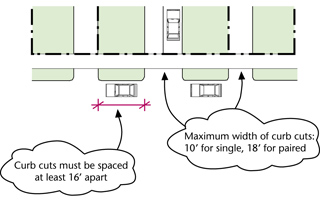
A adjourn cutting is an angled cut in the edge of a curb that permits vehicular admission from a street to a driveway, garage, parking lot or loading dock. In residential districts, width and spacing rules for adjourn cuts ensure adequate curbside parking.
- Adjourn Level
- Curb level is the hateful level of the curb adjoining a zoning lot. In full general, it is the basis for building height and setback controls in medium- and higher-density non-contextual districts and manufacturing districts.
- Density
-

Density refers to the maximum number of dwelling units permitted on a zoning lot. The factors for each district are approximations of average unit of measurement size plus allowances for any common areas. Special density regulations utilise to mixed buildings that contain both residential and customs facility uses.
- Detached Edifice* (see Building)
- Evolution
- A development includes the construction of a new building or other structure on a zoning lot, the relocation of an existing building to another zoning lot, or the establishment of a new open up apply on a tract of land.
- Development Rights
-
Development rights generally refer to the maximum corporeality of floor area permissible on a zoning lot. When the bodily built floor expanse is less than the maximum permitted floor surface area, the difference is referred to as "unused development rights." Unused evolution rights are often described every bit air rights.
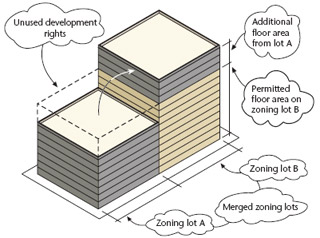
A zoning lot merger is the joining of ii or more adjacent zoning lots into ane new zoning lot. Unused evolution rights may be shifted from i lot to another, as-of-right, just through a zoning lot merger.
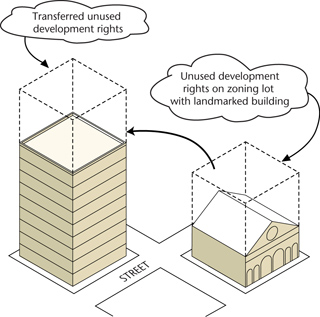
A transfer of development rights (TDR) allows for the transfer of unused development rights from i zoning lot to another in limited circumstances, usually to promote the preservation of celebrated buildings, open space or unique cultural resources. For such purposes, a TDR may be permitted where the transfer could not be achieved through a zoning lot merger. In the case of a landmark building, for case, a transfer may exist made past CPC special permit from the zoning lot containing the designated landmark to an next zoning lot or one that is directly across a street or, for a corner lot, another corner lot on the same intersection.
- Discretionary Action
- A discretionary action requires the review and approving of the City Planning Commission or the Board of Standards and Appeals. Zoning amendments, special permits, authorizations and variances are discretionary deportment.
- Docket
- A docket is the Department of City Planning'due south official description of a proposed land-use action. The docket description is incorporated in the Committee's and Metropolis Council'southward resolution of approving and, except for City Map actions, is the legal and binding description of the activity.
- Dormer
-
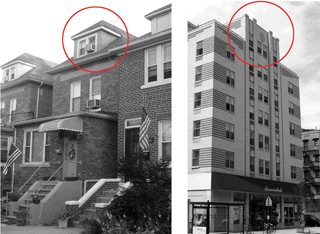
A dormer is a permitted obstacle within a required setback area that may exceed the height of a building. In lower-density districts, information technology is often a window protruding from a sloped roof to provide light and air to the meridian floors of homes. In R6 through R10 contextual districts, dormers are portions of buildings allowed to penetrate a required setback above the maximum base height in club to provide diverseness to the base heights of buildings along a street. Both types of dormers are subject to size limitations.
- Home Unit of measurement
- A dwelling unit consists of one or more than rooms that contain lawful cooking and sanitary facilities, inhabited by ane or more persons living together and maintaining a common household, in a residential edifice or residential portion of a building.
- Enlargement
-
An enlargement is a congenital addition to an existing building that increases the floor area of the building.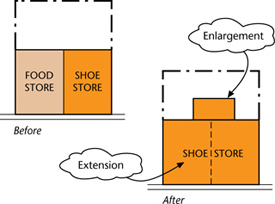
- Extension
- An extension is an expansion of the existing flooring area occupied past an existing utilise.
- Fence
- In residential districts, the maximum peak of a fence synthetic along a front lot line is iv feet in a higher place ground level. The maximum height of a fence forth the side or rear lot line is six feet. In most instances, fences are considered permitted obstructions.
- Floor Area
- The floor area of a building is the sum of the gross surface area of each floor of the building, excluding mechanical infinite, cellar space, floor infinite in open balconies, elevators or stair bulkheads and, in almost zoning districts, floor space used for accompaniment parking that is located less than 23 feet above curb level.
- Floor Surface area Ratio (FAR)
- The flooring area ratio is the main majority regulation decision-making the size of buildings. FAR is the ratio of total edifice floor area to the area of its zoning lot. Each zoning district has an FAR which, when multiplied by the lot surface area of the zoning lot, produces the maximum corporeality of flooring expanse allowable on that zoning lot. For example, on a 10,000 square foot zoning lot in a district with a maximum FAR of 1.0, the floor area on the zoning lot cannot exceed ten,000 square anxiety.
- FRESH Food Store*
- A FRESH food store is a full-line grocery store, established in underserved neighborhoods through zoning incentives, that promotes the sale of fresh food products.
- Forepart Grand* (run into G)
- Front Yard Line*
- A forepart yard line is a line drawn parallel to the front lot line at the depth of a required forepart thou.
- Group Parking Facility
- A group parking facility is a building, structure or lot used for parking that serves more than one dwelling unit of measurement.
- Height Cistron
- The superlative factor of a building is equal to the total flooring area of the edifice divided by its lot coverage (in square feet). In general, the superlative gene is equal to the number of stories in a building constructed without setbacks.
- Height Factor Building
- A height factor building is a edifice containing residences whose residential bulk is determined by a complementary range of acme factors, floor area ratios and open space ratios, and is fix within a sky exposure plane. Height gene regulations promote alpine buildings surrounded by open space. Peak factor buildings are permitted only in R6 through R9 non-contextual districts.
- Home Occupation
- A home occupation is a business operated past the occupant(s) of a home unit of measurement, which is accessory to the residential utilise. It is generally restricted to no more than than 25 per centum of the floor expanse of the dwelling unit (500 sq ft maximum). Occupations that may generate excessive racket, odors or pedestrian traffic are not permitted.
- Incentive Zoning
- Incentive zoning provides a bonus, usually in the course of additional floor area, in exchange for the provision of a public assiduities or affordable housing. There are incentive bonuses for the provision of public plazas (privately owned public spaces), visual or performing arts spaces, subway improvements, theater preservation, FRESH food stores and affordable housing (Inclusionary Housing Program).
- Inclusionary Housing Program
-
The Inclusionary Housing Program provides two optional floor area incentives in exchange for the creation or preservation of affordable housing, on or off-site, predominantly for low-income households.
The original R10 Plan provides a floor surface area bonus of up to 20 percentage, increasing the maximum FAR of 10.0 to 12.0 for the provision of affordable housing in applicable residential and commercial districts with R10 density.
In Inclusionary Housing designated areas* mapped in medium- and high-density residential neighbourhoods and commercial districts with equivalent density, a bonus of 33 per centum of floor expanse can be obtained for providing 20 percent equally affordable housing. The base FAR in designated areas is, in nearly cases, lower than the maximum FAR allowed in the aforementioned zoning district located exterior a designated expanse.
- Income-restricted Housing Unit
- A dwelling unit that complies with the definition of an affordable housing unit of measurement under one of the Inclusionary Housing Programs, or any other dwelling unit of measurement with a legally binding restriction on household income at or below eighty percent of Area Median Income.
- Infill Housing (see Predominantly Built-up Areas)
- Joint Living-Work Quarters for Artists*
- Joint living-work quarters for artists are spaces in nonresidential buildings used for living quarters and work space by artists and their households.
- Large Scale Development
-
A large-scale development is a development generally involving several zoning lots planned as a unit. Large-calibration development regulations allow modifications to various zoning regulations, such as the distribution of flooring area without regard to zoning lot lines, by CPC discretionary action. Such modifications tin allow for design flexibility to reach a superior site plan.
A big-scale general development * is a development or enlargement for any uses permitted by the underlying district regulations in commercial districts (except C1, C2, C3 and C4-i districts) and in all manufacturing districts. The development must be on a tract of land that is at least 1.5 acres and may include existing buildings.
A large-scale residential evolution * is a development designed predominantly for residential uses in residence districts and in C1, C2, C3 and C4-1 districts. The development must exist on a tract of state that is either at least three acres (130,680 sq ft) with a minimum of 500 dwelling house units or at least i.5 acres (65,340 sq ft) with a minimum of three principal residential buildings. Existing buildings may not form any function of a big-calibration residential evolution.
A large-calibration public facility development * is a development or enlargement predominantly for community facility uses in residential districts and in C1, C2, C3 and C4-ane districts. The development must be on a tract of land that is at least three acres (130,680 sq ft) and may include existing buildings.
- Limited Superlative District
- A limited height district may be superimposed on an surface area designated as an historic district by the Landmarks Preservation Committee. It is mapped in areas of the Upper East Side, Gramercy Park, Brooklyn Heights and Cobble Hill. The maximum building height is 50 feet in a LH-1 district, threescore feet in a LH-1A district, 70 feet in a LH-2 commune and 100 feet in a LH-3 commune.
- Loft
- A loft is a edifice or infinite within a building designed for commercial or manufacturing apply, generally constructed prior to 1930. In sure manufacturing districts, lofts may be converted to residential use by CPC special allow.
- Lot or Zoning Lot
-
A lot or zoning lot is a tract of land comprising a single tax lot or two or more than side by side taxation lots within a block. An flat building on a unmarried zoning lot, for instance, may contain separate condominium units, each occupying its own tax lot. Similarly, a building containing a row of townhouses may occupy several divide tax lots within a single zoning lot, or ii or more discrete homes on ane zoning lot may each have its own taxation lot.
The zoning lot is the basic unit for zoning regulations and may be subdivided into ii or more zoning lots, and ii or more adjoining zoning lots on the aforementioned block may be merged, provided that all resulting zoning lots comply with applicable regulations.
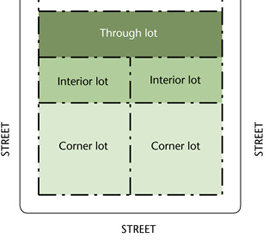
A corner lot * is a zoning lot that adjoins the signal of intersection of two or more streets; it is besides a zoning lot bounded entirely by streets.
An interior lot * is any zoning lot that is neither a corner lot nor a through lot.
A through lot * is any zoning lot that connects two generally parallel streets and is not a corner lot.
- Lot Area
- Lot area is the expanse (in foursquare anxiety) of a zoning lot.
- Lot Coverage
- Lot coverage is that portion of a zoning lot which, when viewed from above, is covered by a edifice. Permitted obstructions are not counted towards lot coverage calculations.
- Lot Depth
- Lot depth is the mean horizontal altitude between the front lot line and rear lot line of a zoning lot.
- Lot Line or Zoning Lot Line
-
A lot line or a zoning lot line is a boundary of a zoning lot.
A front lot line ,* also known every bit a street line, is that portion of a zoning lot line that fronts upon a street.
A rear lot line * is any lot line that is generally parallel to a street line bounding the zoning lot and does not intersect a street line.
A side lot line * is any lot line that is neither a forepart lot line nor a rear lot line.
- Lot Width
- Lot width is the mean horizontal distance between the side lot lines of a zoning lot.
- Lower Density Growth Management Expanse
- A Lower Density Growth Management Area is a designated area that is generally afar from mass transit and characterized by rapid growth and high automobile ownership, such equally Staten Island or the Throgs Cervix expanse of the Bronx. New developments must provide more than off-street parking, larger yards and more open space than would otherwise be required in the mapped zoning districts.
- Manhattan Core
- The Manhattan Core extends from the southern tip of Manhattan at The Bombardment to West 110th Street on the Westward Side and E 96th Street on the East Side. It is the area covered past Manhattan Community Districts 1 through viii.
- Manufacturing District
- A manufacturing commune, designated by the letter M (M1-one, M2-2, for example), is a zoning district in which manufacturing uses, nigh commercial uses and some community facility uses are permitted. Industrial uses are subject to a range of functioning standards. Residential evolution is not allowed, except in M1-1D through M1-5D districts by CPC authorization, and in M1-6D districts, as-of-right or by CPC certification.
- Manufacturing Utilize
- A manufacturing use is any apply listed in Use Group 17 or 18, or an industrial apply only allowed by special allow.
- Mixed Building*
-
A mixed building is a building in a commercial commune used partly for residential employ and partly for community facility or commercial employ.
When a edifice contains more one use, the maximum FAR permitted on the zoning lot is the highest FAR immune for any of the uses, provided that the FAR for each apply does not exceed the maximum FAR permitted for that employ. In a C1-8A district, for example, where the maximum commercial FAR is 2.0 and the maximum residential FAR is seven.52, the total permitted FAR for a mixed residential/commercial building would be 7.52, of which no more 2.0 FAR may be applied to the commercial space.
- Mixed Employ Commune*
- A mixed use district is a special purpose district where one set of regulations applies to many unlike areas shown on the zoning maps as MX with a numerical suffix (MX-8, for example). In MX districts, an M1 commune is paired with a residential district (M1-two/R6, for example) and new residential and non-residential uses are permitted equally-of-right inside the aforementioned building. In this district, a building that contains a residential use and any other use is a mixed use building.
- Narrow Street* (see Street)
- Non-complying or Non-compliance
- A non-complying building is whatsoever building that no longer complies with one or more than of the bulk regulations of the applicable zoning commune. The degree of non-compliance may non be increased. Regulations governing non-complying buildings can be found in Article V, Chapter 4, of the Zoning Resolution.
- Non-conforming or Non-conformity
- A not-befitting use is any use that no longer conforms to one or more of the utilize regulations of the applicable zoning district. The degree of non-conformance may not be increased. Regulations governing non-conforming uses can be found in Article V, Capacity two and 3, of the Zoning Resolution.
- Open up Infinite*
- Open up space is the part of a residential zoning lot (which may include courts or yards) that is open and unobstructed from its lowest level to the sky, except for specific permitted obstructions, and accessible to and usable past all persons occupying home units on the zoning lot. Depending upon the district, the amount of required open up space is determined past the open up infinite ratio, minimum yard regulations or by maximum lot coverage.
- Open up Space Ratio (OSR)
- The open space ratio is the corporeality of open space required on a residential zoning lot in non-contextual districts, expressed as a percentage of the total flooring area on the zoning lot. For example, if a edifice with 20,000 square feet of flooring expanse has an OSR of 20, 4,000 square anxiety of open infinite would be required on the zoning lot (0.20 × 20,000 sq ft).
- Overlay District
- An overlay district is a district superimposed upon another district which supersedes, modifies or supplements the underlying regulations. Limited superlative districts and commercial overlay districts are examples of overlay districts.
- Paired Districts
- A paired commune matches an M1 district with an R3 through R10 district (M1-5/R10, for example) to permit a mixture of residential and non-residential (commercial, community facility, low-cal manufacturing) uses in the same zoning district, cake or building. Paired districts are mapped in Special Mixed Use Districts and in the Special Long Isle Metropolis Mixed Use District.
- Parapet
- A parapet is a low wall or protective barrier that extends vertically to a higher place the roof of a edifice or other structure. A parapet wall that is no higher than four anxiety is a permitted obstruction and may penetrate a maximum tiptop limit or required setback surface area.
- Parking Requirement Category (PRC)
-
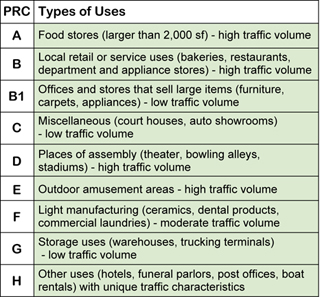
Parking requirements for commercial uses are grouped into nine parking requirement categories based on the compatibility of the uses and the amount of traffic generated.
- Performance Standard
- A performance standard is a minimum requirement or maximum allowable limit on racket, vibration, smoke, odour and other effects of industrial uses listed in Use Groups 17 and 18.
- Perimeter Wall
- Perimeter walls are the outermost walls of a building in a lower-density commune that enclose floor expanse and rise from the base of operations plane to a specified maximum height.
- Permitted Obstruction
- A permitted obstruction is a structure or object that may exist located in a required thousand or open space or penetrate a peak limit, setback area or heaven exposure plane. A balcony, trellis, air conditioner, gutter or fence is a permitted obstruction in required yards or open space. Certain structures on a roof, such every bit lift bulkheads, h2o towers or parapets are permitted obstructions that may penetrate superlative limits, setback areas or sky exposure planes.
- Pierhead Line (meet Waterfront Area)
- Planting Strips
- Planting strips are grassy areas that extend forth the edge of the curb within which street trees are planted in R1 through R5 districts. Planting strips are a required streetscape comeback in certain districts.
- Predominantly Congenital-up Expanse
- A predominantly built-up area is a blockfront entirely within an R4 or R5 district (without a suffix) in which optional regulations that permit higher floor area ratios and lower parking requirements may exist used to produce infill housing. At least 50 percent of the surface area of the block must be occupied by zoning lots developed with buildings, and the zoning lot that volition be developed with infill housing may not exceed i.5 acres (65,340 sq ft). Infill regulations may not be used to redevelop a lot occupied by a one- or ii-family unit discrete or semi-detached house unless the blockfront is predominantly developed with fastened or multifamily housing.
- Private Road
- A individual road is a right-of-way that gives vehicular access to developments with v or more dwelling units that are located at least 50 feet from a public street in R1 through R5 districts. Developments on private roads must comply with special pattern rules. In lower density growth management areas, a correct-of-way that provides access to 3 or more domicile units is a private road.
- Privately-owned Public Space
- A privately owned public space is an amenity provided and maintained by the property owner for public use, usually in exchange for additional floor area. Located mainly in the high-density, central business districts of Manhattan, these spaces are typically in the class of an arcade or a public plaza with seating and landscaping and may be located within or exterior a building.
- Public Park
- A public park is any publicly endemic park, playground, beach, parkway, or roadway inside the jurisdiction and command of the New York Urban center Commissioner of Parks & Recreation. Typically, public parks are not subject to zoning regulations.
- Public Parking Garage
- A public parking garage is a building or office of a building that is used on a daily basis for public parking. A public parking garage may include some accessory off-street parking spaces for uses on the same zoning lot.
- Public Parking Lot
- A public parking lot is a tract of land that is used on a daily footing for public parking and is not accessory to a use on the same or some other zoning lot.
- Public Plaza
- A public plaza is a privately owned open area adjacent to a building and accessible to the public. It must by and large be at the level of the sidewalk information technology adjoins and be unobstructed to the sky except for seating and other permitted amenities. In certain high-density zoning districts, a floor area bonus is bachelor for the provision of a public plaza.
- Qualifying Ground Floor
- A basis floor of a development or enlargement of a Quality Housing building, where the start of the 2nd story is xiii anxiety or more above the level of the sidewalk and, in sure instances, where additional supplementary use provisions are met. In some zoning districts, buildings with a Qualifying Ground Floor are permitted a higher maximum base of operations and overall meridian.
- Quality Housing Programme
- The Quality Housing Programme, mandatory in contextual R6 through R10 residence districts and optional in non-contextual R6 through R10 districts, encourages development consistent with the grapheme of many established neighborhoods. Its bulk regulations prepare elevation limits and allow high lot coverage buildings that are set at or near the street line. The Quality Housing Program also requires amenities relating to interior space, recreation areas and landscaping.
- Railroad or Transit Air Infinite
- Railroad or transit air infinite is space directly over an open up railroad or transit correct-of-manner or chiliad in existence on or subsequently September 27, 1962. Development may be permitted but by CPC special permit.
- Rear Yard* (run across Thousand)
- Rear Thousand Equivalent (see 1000)
- Residence*
-
A residence consists of i or more dwelling house units or rooming units, and any common areas, including one-family unit and ii-family houses, multifamily dwellings or flat hotels.
A unmarried-family residence * is a building on a zoning lot containing one home unit occupied by one household.
A two-family residence * is a building on a zoning lot containing two domicile units occupied by two households. In R3-ane, R3A, R3X, R4-ane and R4A districts, two-family houses, both detached and semi-detached, must have at least 75% of one dwelling unit directly above or below the other.
A multifamily residence is a building on a zoning lot containing at least three dwelling units.
- Residence District
- A residence district, designated by the alphabetic character R (R3-two, R5, R10A, for case), is a zoning district in which only residences and community facilities are permitted.
- Residential Commune Equivalent
- A residential district equivalent is a residential district designation assigned to a C1, C2, C3, C4, C5 or C6 district that establishes the regulations for residential development within the district. Any residential development in a C4-4 district, for example, must follow the bulk regulations of its residential equivalent, an R7 district.
- Residential Utilise
- A residential use is any employ listed in Utilize Grouping 1 (single-family detached residences) or Employ Group 2 (all other types of residential development).
- Restrictive Declaration
- A restrictive declaration is a covenant running with the land that binds the present and future owners of the property. Restrictive declarations are used to implement the conditions of a country utilize blessing or ensure implementation of environmental mitigations and project components.
- Rezoning
- A rezoning or remapping occurs when the zoning designation(s) for an expanse is changed on the zoning map to facilitate policy initiatives, such as preserving neighborhoods and promoting economic evolution around transit hubs. A zoning map amendment is subject to the ULURP review procedure.
- Semi-discrete Edifice* (see Edifice)
- Setback, Building
-
A setback is the portion of a building that is ready back to a higher place the base height (or street wall or perimeter wall) earlier the total meridian of the building is achieved. The position of a building setback in height cistron districts is controlled by sky exposure planes and, in contextual districts, by specified distances from street walls.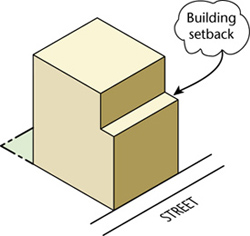
- Setbacks, Front Yard or Ground Level
-
Front yards are required in R1 through R5 districts; rules governing the depth of open areas at ground level between the forepart building wall and the street line apply in R6 through R10 districts. Front yards and open areas must be planted and take a minimum depth that meets the post-obit requirements:
R2A, R3A, R3X, R4A, R4-1 and R5A
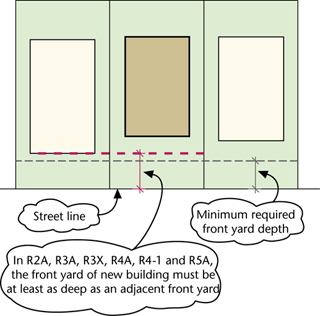
In R2A, R3A, R3X, R4A, R4-one and R5A districts, if the adjacent front yards are deeper than the minimum required front yard, a new edifice must provide a front yard at least as deep as one of the adjacent yards, just it need not be deeper than 20 feet.
R4B, R5B and R5D
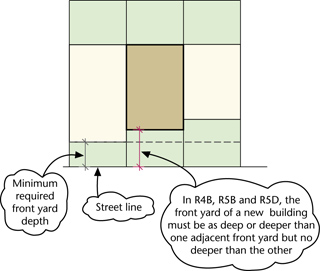
In R4B, R5B and R5D districts, if the adjacent forepart yards are deeper than the minimum required front 1000, then the front g of a new building must be at least as deep as one adjacent front g and no deeper than the other, just it need not be deeper than 20 feet.
R6B, R7B and R8B
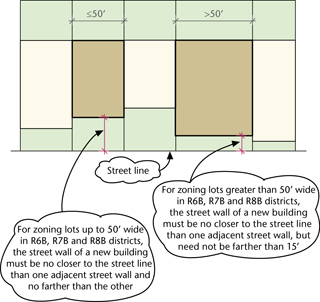
In R6B, R7B and R8B districts, the street wall of a new building, on whatsoever lot upward to 50 anxiety wide, must be equally deep as one adjacent wall and no deeper than the other. On lots wider than 50 feet, the street wall of a new building may be no closer to the street line than the street wall of an side by side building. A street wall need not exist located further from the street line than 15 anxiety.
R6A, R7A and R7X
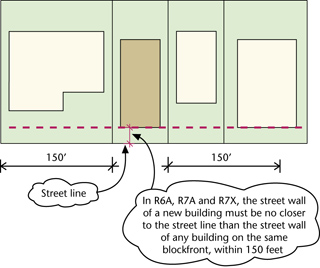
In R6A, R7A, 7D and R7X districts, the street wall of a new building may be located no closer to the street line than the street wall of any building within 150 feet on the same blockfront, but demand not be located farther from the street line than 15 feet.
- Shore Public Walkway* (meet Waterfront Public Access Expanse)
- Shoreline (see Waterfront Expanse)
- Side Lot Ribbon
-
A side lot ribbon is an 8 to 10 pes wide strip that extends along the length of the side lot line of a zoning lot. It is not required to exist open to the heaven and can extend through an attached firm set along the side lot line. In R3, R4 and R5 districts, if a zoning lot is less than 35 feet wide, parking must exist located in a side lot ribbon.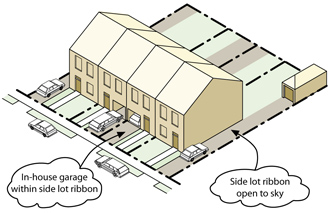
- Side Yard* (come across Yard)
- Sidewalk cafe
-
A sidewalk cafe is a portion of an eating or drinking establishment that is located on a public sidewalk. Sidewalk cafe regulations are administered by the Department of Consumer Diplomacy.
An enclosed sidewalk cafe * is a sidewalk cafe that is contained inside a structure.
An unenclosed sidewalk cafe * contains readily removable tables, chairs or railings, with no overhead coverage other than umbrellas or a retractable awning.
A small sidewalk cafe * is an unenclosed sidewalk cafe containing no more than than a single row of tables and chairs in a space no greater than four½ anxiety from the street line, with no barrier betwixt the café and the sidewalk.
- Sign
-
A sign is any writing—words, pictures or symbols—that is on or attached to a building or other structure.
An accompaniment sign * directs attention to a business organisation, profession, commodity, service or amusement conducted, sold or offered upon the aforementioned zoning lot.
An advertisement sign * directs attention to a business, profession, article, service or amusement conducted, sold or offered on a dissimilar zoning lot.
A flashing sign * is whatever illuminated sign, whether stationary, revolving or rotating, which changes calorie-free or color.
An illuminated sign * uses artificial calorie-free or reflected lite from an artificial source.
- Sketch Maps
- A sketch map is an analogy of a proposed change to the Zoning Map or the Urban center Map that provides a graphic, piece of cake to read version of the alter. The sketch map is attached to the Observe of Certification (NOC) when an application for a Zoning Map or City Map modify is certified as complete by the Section of City Planning and distributed for public review. Sketch maps are express in scope and scale to include only the area affected by the proposed action and do not necessarily reflect the concluding activity.
- Sky Exposure Aeroplane
-
A sky exposure plane is a virtual sloping plane that begins at a specified superlative above the street line and rises inward over the zoning lot at a ratio of vertical distance to horizontal distance set forth in district regulations. A edifice may non penetrate the heaven exposure aeroplane which is designed to provide calorie-free and air at street level, primarily in medium- and higher-density districts.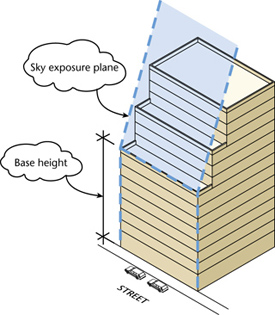
- Sliver Building
- A tall building or enlargement that is 45 feet wide or less, in an R7-2, R7X, R8, R9 or R10 district, is usually called a sliver building. Such buildings are generally restricted to a height equal to the width of the abutting street or 100 anxiety, whichever is less.
- Special Let
- A special permit is a discretionary action by the City Planning Committee (CPC), field of study to ULURP review, or the Board of Standards and Appeals (BSA), which may modify use, bulk or parking regulations if certain conditions and findings specified in the Zoning Resolution are met. Applications for special permits under CPC jurisdiction more often than not concern employ or bulk modifications with potential for greater state employ impacts than those reviewed by the BSA.
- Special Purpose Commune
- The regulations for special purpose districts are designed to supplement and change the underlying zoning in order to reply to distinctive neighborhoods with particular issues and goals. Special purpose districts are shown equally overlays on the zoning maps and are in Manufactures 8–Xiii of the Resolution.
- Split Lot
-
A split lot is a zoning lot located in two or more zoning districts and divided by a zoning district boundary. In most cases, zoning regulations for each district must be applied separately for each portion of the lot. Special rules for zoning lots that existed prior to 1961, or prior to any rezoning that splits a lot, can be institute in Article VII, Affiliate 7, of the Zoning Resolution.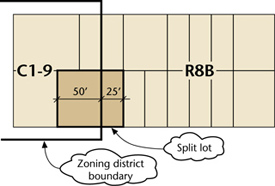
- 25 Foot Rule
- The 25 pes rule applies to an existing zoning lot split between two or more than zoning districts that allow different uses or have dissimilar bulk rules (C1-ix and R8B, for instance). When the width of 1 district measures 25 feet or less at every point, the utilize and bulk regulations of the larger district can be applied to the unabridged zoning lot.
- Story
- A story is that office of a edifice betwixt the surface of ane floor and the ceiling immediately above. A cellar does non count as a story.
- Street
-
A street is any road (other than a private road), highway, parkway, artery, alley or other way shown on the Metropolis Map, or a way at to the lowest degree 50 feet broad and intended for public use which connects a way shown on the City Map to another such way or to a building or construction. A street refers to the unabridged public right-of-way (including public sidewalks).
A narrow street * is a street that is less than 75 feet broad.
A wide street * is a street that is 75 feet or more in width. Most bulk regulations applicable to wide streets are also applicable to buildings on intersecting streets within 100 feet of a wide street.
- Street Line*
- A street line is a front lot line separating the zoning lot from the street.
- Street Wall
- A street wall is a wall or portion of a wall of a building facing a street.
- Supplemental Public Access Area* (see Waterfront Public Access Surface area)
- Tax Lot
- A taxation lot is a parcel of land identified with a unique civic, cake and lot number for property taxation purposes. A zoning lot comprises one or more adjacent tax lots inside a block.
- Tower
-
A tower is a portion of a edifice that penetrates the sky exposure plane and is allowed simply in specified high-density areas of the urban center. A belfry may be occupied past residential, commercial or community facility uses.
The standard belfry rules generally allow the tower portion of a building to encompass no more than forty percent of the expanse of the zoning lot, or up to fifty percent on lots smaller than 20,000 square feet. The belfry portion of a building must be set back at least 10 feet from a wide street and at to the lowest degree 15 anxiety from a narrow street. These regulations are modified for different uses and districts.
A tower-on-a-base requires a contextual base between lx and 85 anxiety high that extends continuously along the street line. The superlative of the tower is controlled past a minimum lot coverage requirement and a rule that at least 55 percent of the floor expanse on the zoning lot be located below a height of 150 feet. On a wide street in R9 and R10 districts and their C1 or C2 equivalents, a building that includes a residential tower must comply with tower-on-a-base regulations in add-on to the standard tower rules.
- Transfer of Development Rights (see Development Rights)
- Transit Zone
- An area where special lower accessory parking requirements utilize for various types of affordable housing including income-restricted housing units. These are generally areas of the city across the Manhattan Core within one-half mile of a subway station where auto ownership rates are among the lowest in the urban center.
- Uniform Country Apply Review Procedure (ULURP)
- The Uniform Country Use Review Process (ULURP) is the public review process, mandated by the City Lease, for all proposed zoning map amendments, special permits and other actions such equally site selections and acquisitions for city capital projects and disposition of city property. ULURP sets forth a time frame and other requirements for public participation at the Community Board, Borough Board and Borough President levels, and for the public hearings and determinations of the Community Boards, Borough Presidents, Metropolis Planning Commission (CPC) and City Council. Zoning text amendments follow a like review process, merely without a time limit for CPC review.
- Upland Connection* (see Waterfront Public Access Area)
- Use
- A use is any activeness, occupation, business organization or operation, listed in Use Groups 1 through xviii, or identified in a special let, which is conducted in a edifice or on a tract of land. Certain uses are allowed only by special permit of the CPC or BSA.
- Use Grouping
- Uses that take similar functional characteristics and/or nuisance impacts and are more often than not compatible with each other are listed in one or more of 18 groups that are categorized as residential uses (Use Groups ane–2), customs facility uses (Utilize Groups 3–4), retail and service uses (Utilise Groups 5–9), regional commercial centers/amusement uses (Use Groups ten–12), waterfront/recreation uses (Employ Groups xiii–15), heavy automotive uses (Use Grouping 16) and industrial uses (Employ Groups 17–xviii). Use grouping charts tin be found in Chapter 2 of Articles II, Iii and 4 of the Zoning Resolution.
- Variance
- A variance is a discretionary activeness past the Lath of Standards and Appeals which grants relief from the use and bulk provisions of the Zoning Resolution to the extent necessary to permit a reasonable or applied use of the land. A variance may be granted, later a public hearing, when unique conditions on a specific parcel of state would cause the holding possessor practical difficulty and undue hardship if it were developed pursuant to applicable provisions.
- Waterfront Access Program (WAP)
- A waterfront access plan is a detailed framework gear up forth in the Zoning Resolution, that tailors waterfront bulk regulations and public admission requirements to the specific conditions of a particular waterfront. Development of private waterfront parcels governed by the program triggers a requirement to build and maintain public admission areas in accordance with the WAP.
- Waterfront Area
-
A waterfront area is the geographical surface area next to a trunk of water at to the lowest degree 100 feet broad, comprising all blocks betwixt the pierhead line and a parallel line 800 anxiety landward from the shoreline. Blocks within the waterfront area are subject to waterfront zoning regulations.
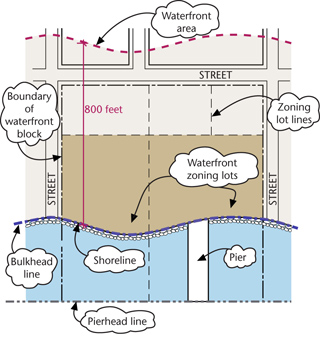
The bulkhead line is a line shown on the zoning maps which divides the upland and seaward portions of waterfront zoning lots.
The pierhead line is a line shown on the zoning maps which defines the outermost seaward boundary of the area regulated past the Zoning Resolution.
The shoreline * is the mean high water line.
A waterfront block*, waterfront public park* or waterfront zoning lot* is a block, public park or zoning lot in the waterfront expanse that is adjacent to or intersected past the shoreline.
- Waterfront Public Access Surface area*
-
A waterfront public access area (WPAA) is the portion of a waterfront zoning lot where publicly accessible open space is provided to and along the shoreline. All WPAAs are required to be improved with landscaping and trees, seating and other amenities. WPAAs can include a shore public walkway, an upland connection, a supplemental public access surface area, a public access expanse on a pier or floating structure, or whatsoever additional expanse improved for public employ. The minimum corporeality of waterfront public access expanse required is a specified percentage for the zoning lot.
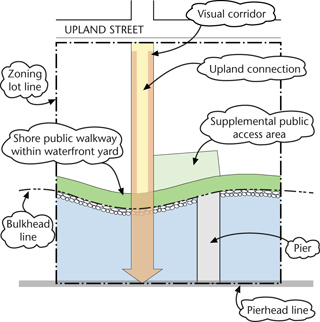
A shore public walkway* is a linear public access area running alongside the shore.
An upland connection* is a pedestrian style between a public place (a street, a sidewalk or a park, for example) and a shore public walkway. Upland connections may be provided along a private route.
A supplemental public access expanse * is a public access area required in order to fulfill the minimum percentageage of WPAA required on a waterfront zoning lot, once a shore public walkway and upland connection have been provided.
- Waterfront One thousand*
- A waterfront g is the portion of a waterfront zoning lot extending along the entire length of the shoreline which must exist open and unobstructed from the lowest level to the sky, except for sure permitted obstructions. Depending upon the zoning district, the minimum depth is typically xxx to forty anxiety. Shore public walkways are required to be located within the waterfront thou.
- Broad Street* (see Street)
- Window, Legally Required*
- Legally required windows are mandated in domicile units to provide necessary light, air and ventilation. Legally required windows cannot exist located on or closer than 30 anxiety to a lot line.
- Grand
-
A yard is a required open area forth the lot lines of a zoning lot which must be unobstructed from the lowest level to the heaven, except for certain permitted obstructions. Thousand regulations ensure low-cal and air betwixt structures.
A forepart yard * extends along the full width of a front lot line. In the case of a corner lot, any g extending along the full length of a street line is considered a front yard. (See likewise Setbacks, Front end 1000 or Ground Level)
A rear yard * extends for the full width of a rear lot line. In residential districts, the minimum depth of a rear yard is xxx anxiety, except in R2X districts. In commercial, manufacturing and R2X districts, the minimum depth of a rear 1000 is 20 anxiety. A corner lot is not required to have a rear g. In commercial and manufacturing districts, and for some community facility buildings in residence districts, the rear g may be occupied entirely past a single-story building up to a superlative of 23 feet.
A rear yard equivalent * is an open surface area on a through lot required to comply with rear yard regulations.
A side yard * extends along a side lot line from the required front yard, or from the front lot line if no front one thousand is required, to the required rear yard, or to the rear lot line if no rear g is required. In the case of a corner lot, any yard that is not a front one thousand is considered a side yard.
- Aught Lot Line Building* (see Building)
- Zoning District
- A zoning commune is a residential, commercial or manufacturing area of the city within which zoning regulations govern land use and building bulk. Special purpose zoning districts have distinctive qualities where regulations are tailored to the neighborhood. Zoning districts are shown on the zoning maps.
- Zoning Lot* (meet Lot)
- Zoning Lot Merger (see Development Rights)
- Zoning Maps
- The 126 New York City zoning maps bespeak the location and boundaries of zoning districts and are function of the Zoning Resolution. Each map covers a land area of approximately 8,000 anxiety (north/due south) past 12,500 anxiety (eastward/due west). Zoning map amendments, or rezonings, are subject to ULURP review.
Source: https://www1.nyc.gov/site/planning/zoning/glossary.page
0 Response to "Appeal to City Council on Building Multi Family, Can We Take Back Our Appeal and Get Your Money Back"
Post a Comment